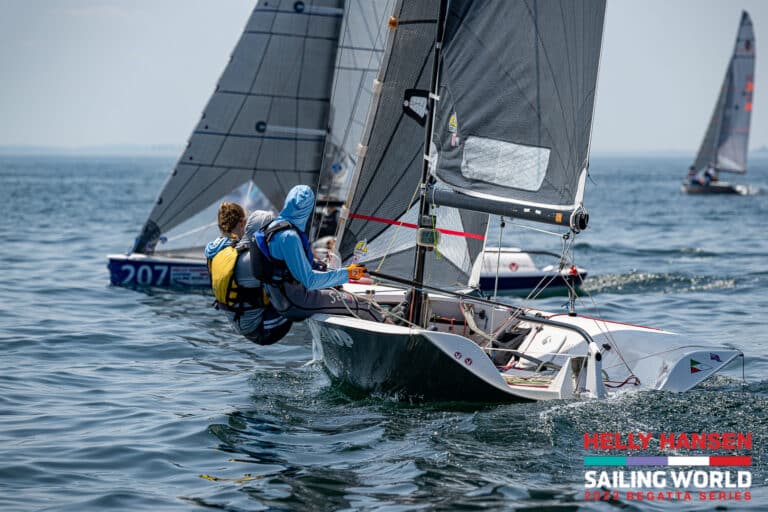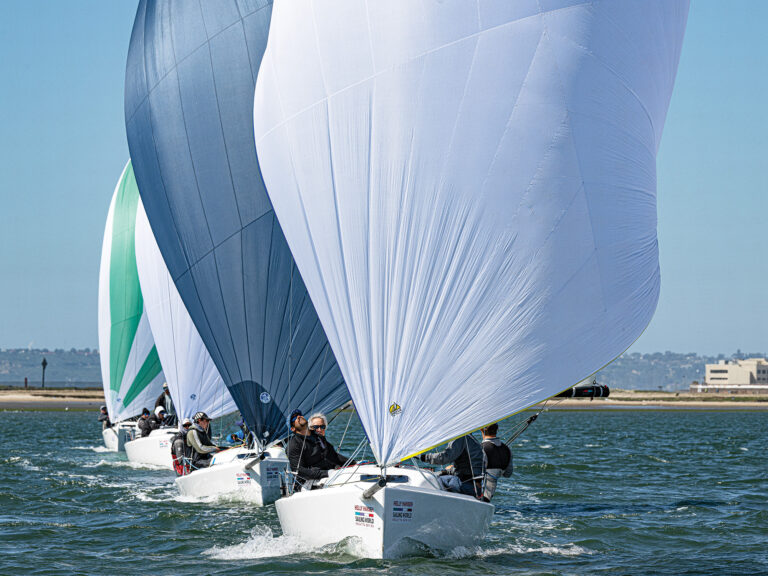The most expeditious way to prepare as a team and to attain the consistency that is so often spoken of by top teams is to develop a pre-race routine and apply it to every race. Each team’s routine will be different, but the goal is to make it a habit; once you’ve done that you’re on your way to better, more consistent results. Much of a pre-race routine involves the essential basics, but trust me, from many years of instructing and coaching I can tell you that it’s these basics that are regularly put aside in favor of more sophisticated and overly technical distractions. I’ve come up with a working list, which I know you’ll find useful as well.Before you leave the dock1.) Rig the boat as a team, which ideally means everyone shows up on time, and keep your eyes open for rigging mistakes, such as misled spinnaker and jib sheets. The bow team should practice setting the pole a few times to get warmed up. If there’s a new team member, specifically one relegated to the pit or some other bow-related position, this is a great chance to give them an orientation and explain their body placement and responsibilities. 2.) Remove any extra weight from the ends of the boat. This means clearing shelves and taking off things that are not necessary or required by class rules. Have everyone carefully consider the amount of gear they’re bringing on board. In other words, keep the boat on a perpetual diet. 3.) Load the sails on the bunks so they’re not trampled (but when racing, have them placed over the keel, stacked in the order in which they will be likely used, based on the wind forecast). Also, set the shrouds, and/or headstay, at their base (middle) settings, using your boat’s tuning guide.Using the “victory hour”4.) Get to the race area before everyone else-this is a victory in itself! Make it a point to have at least one hour of prep time before the gun, and use every minute of it.5.) If it’s a long sail or motor out to the race area, use this time to talk about the day, integrate new crew members, and review the sailing instructions and agree on them as a team. 6.) Sail upwind on starboard tack and dial in with speed and the compass as soon as you reach the starting area.7.) If possible, take an opportunity to tune with another early arrival. Split tacks with them for 3 to 5 minutes and see which side is favored when you converge. If they’re faster, determine why. Is it their setup? This is also a great time to start the communication flow from the rail; what’s your speed and height relative to the other boats? Start talking about the breeze, particularly calling the lulls as well as the puffs.8.) Check the genoa halyard tension. Is the draft in the right place? Note the main halyard setting and backstay tension. If it’s puffy, pull on the the backstay for maximum power and critique your mainsail leech tension. Is the top batten telltale flying 60 percent and stalling 40 percent of the time?9.) Focus on straight-line speed and consistent minimum heel angle, check out the current, and monitor the compass headings, regularly writing them down. 10.) Check the rig tension and headstay settings by sending someone up to look at the headstay sag and sideways sag of the mast. If the rig is too loose, the main will flog and the forestay will sag excessively to leeward, causing the mainsail to backwind. You will also notice the leeward shrouds dangling more than they should. If the rig is too tight, the boat will feel dead; the main and genoa will look very flat and the headstay will look too rigid, even with no backstay applied. The leeward shrouds will look tight as well. If this is the case, ease the rig and set the boat up for power in the lulls, not depowered for the puffs. 11.) Practice tacking, focusing on being smooth by easing the boat into the tack and dropping the genoa inside the lifelines. You can never get too good at this. If the boat is struggling out of the tack, keep the sails powered. Ease the sheets a few inches to open the leech of the sails, which will help build speed. The lighter and choppier the conditions, the more important this becomes.12.) Sail to the other side of the course and check the current. Watch the compass for shifts and wind trends, and write down the numbers in a place visible to the tactician. Look at the geography and determine whether and how it’s influencing the wind.13.) Round a windward mark (real or imaginary) and practice a spinnaker set. Make sure no one moves to the cabin top early, and that the weight is distributed low and to the sides to dampen rolling and pitching. The bow person and tactician are looking back for wind, the spinnaker trimmer is talking about pressure on the sheet, and the communication is getting warmed up!14.) Critique the vang tension-is the top batten parallel to the boom? Adjust it and be conscious of it for the first downwind leg.15.) Determine the optimum pole height. Or, if using an asymmetric sail, how does the tack height look? Keep the center seam vertical and the sail breaking in the middle of the luff, and then mark the topping lift or tack line when you find generally good settings.16.) Practice jibing. The goal here is minimum helm, if it’s light air. Move the crew weight to windward to help roll the boat. Jibe the mainsail and spin pole simultaneously so they’re both flying. Make sure to keep the spinnaker perpendicular to the wind, rotating the spinnaker on the jibe. Keep the bow of the boat under the center seam of the spinnaker if it is windy. If it’s light, it’s critical for the trimmer to talk about pressure on the spinnaker sheet all the time, particularly while coming out of a jibe, so the team can get to the correct angle as soon as possible. Practice as many jibes as you possibly can-it will get everyone in sync.17.) Practice a takedown and leeward rounding and critique it. Did we go wide enough to come out tight to the mark, close hauled, and with speed? The genoa trimmer must trim the headsail perfectly to every point of sail for maximum speed, and the skipper can do a “check luff” by pinching 5 degrees to get the inside telltale to dance on the genoa to make sure he’s right on the wind.Cue up for the start18.) Go to the start line and check in with the race committee, hailing your sail numbers. Check the course and any displayed flags.19.) With the genoa on deck, run the line on starboard tack and note the compass heading. Add 90 degrees and write this number down so you don’t forget it.20.) Go head to wind; get the boat stopped in clear air. Write down the heading. If it less than the number you wrote down when running the line, then the pin end is favored. If the heading is greater, then the race committee end is favored.21.) Stay near the line and tack whenever possible, each time, taking a head-to-wind reading in clear air. If the current is pushing you over the line, jibe to stay away from it. Don’t forget to use this time to back down and clear the rudder and keel. 22.) If other fleets are starting before you, watch their starts from the pin end. If boats that are starting look to be bow down on starboard tack, the pin end is favored. If they are bow up, or bow even, then the committee boat is favored, or the line is square. Observe their laylines to the start, and look for the barging layline and the safe layline. While you’re at it, look for the pin-end layline, and watch to see if pin starters struggle to make that end. 23.) Fifteen minutes before your start, make a final decision on the rig tension.24.) At 8 minutes, take another head-to-wind reading while you put the genoa up and set halyard tension. Determine what phase the wind is in and verbalize your starting strategy to the entire team; it’s good to get everyone on the same page. 25.) Watch the fleet carefully. Where are they setting up? Go for a low-density area start with clear air and a big gap to leeward. This is supremely important because you can sail fast and avoid getting pinched off by a leeward boat. 26.) Carve a big gap to leeward by luffing with the mainsail trimmed and the genoa eased. You can then use this gap to close reach and build speed before turning up to closehauled. If it’s windy, ease the vang to help you slow down and hold your spot while creating a hole to leeward. 27.) Focus on speed and getting away from the fleet, and in the final seconds, keep the boat going fast by hiking harder than the other teams. Don’t pinch, and try to get away from other boats that are! At the end of the race, stay near the line, re-hoist the main halyard, which often slips during a race, pack the spinnakers, and do your start line R&D as soon as you can after hydrating. Designate a person to give the helmsperson a break between races, and once everyone is settled, start back at No. 6 (above), treating the next race as if it were the first.









